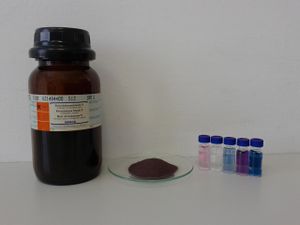Difference between revisions of "Eriochrome Black T"
Diachrynic (Talk | contribs) |
|||
| Line 5: | Line 5: | ||
| PIN = Sodium 1-[1-Hydroxynaphthylazo]-6-nitro-2-naphthol-4-sulfonate | | PIN = Sodium 1-[1-Hydroxynaphthylazo]-6-nitro-2-naphthol-4-sulfonate | ||
| SystematicName = Sodium 4-[2-(1-hydroxynaphthalen-2-yl)hydrazin-1-ylidene]-7-nitro-3-oxo-3,4-dihydronaphthalene-1-sulfonate | | SystematicName = Sodium 4-[2-(1-hydroxynaphthalen-2-yl)hydrazin-1-ylidene]-7-nitro-3-oxo-3,4-dihydronaphthalene-1-sulfonate | ||
| − | | OtherNames = Fast Chrome Black T<br>Hispacrom Black T<br>Mordant Black 11<br>Sodium 4-[2-(1-hydroxynaphthalen-2-yl)hydrazin-1-ylidene]-7-nitro-3-oxonaphthalene-1-sulfonate<br>Solochrome Black T | + | | OtherNames = Erio T<br>Fast Chrome Black T<br>Hispacrom Black T<br>Mordant Black 11<br>Sodium 4-[2-(1-hydroxynaphthalen-2-yl)hydrazin-1-ylidene]-7-nitro-3-oxonaphthalene-1-sulfonate<br>Solochrome Black T |
<!-- Images --> | <!-- Images --> | ||
| ImageFile = Eriochrome Black T sample solutions.jpg | | ImageFile = Eriochrome Black T sample solutions.jpg | ||
| Line 109: | Line 109: | ||
}} | }} | ||
}} | }} | ||
| − | '''Eriochrome Black T''' ('''EBT''') is an azo dye used as complexometric indicator in complexometric titrations, most common in determining water hardness. | + | '''Eriochrome Black T''' ('''EBT''' or '''Erio T''') is an azo dye used as complexometric indicator in complexometric titrations, most common in determining water hardness. |
==Properties== | ==Properties== | ||
Revision as of 18:42, 26 September 2020
 Eriochrome Black T sample and as solution. From left to right: dissolved in distilled water, in distilled water with NH3, in tap water, in tap water with NH3 and in tap water with NH3 end point titrated with EDTA.
| |
| Names | |
|---|---|
| IUPAC name
Sodium (4Z)-4-[(1-hydroxynaphthalen-2-yl)hydrazinylidene]-7-nitro-3-oxonaphthalene-1-sulfonate
| |
| Preferred IUPAC name
Sodium 1-[1-Hydroxynaphthylazo]-6-nitro-2-naphthol-4-sulfonate | |
| Systematic IUPAC name
Sodium 4-[2-(1-hydroxynaphthalen-2-yl)hydrazin-1-ylidene]-7-nitro-3-oxo-3,4-dihydronaphthalene-1-sulfonate | |
| Other names
Erio T
Fast Chrome Black T Hispacrom Black T Mordant Black 11 Sodium 4-[2-(1-hydroxynaphthalen-2-yl)hydrazin-1-ylidene]-7-nitro-3-oxonaphthalene-1-sulfonate Solochrome Black T | |
| Properties | |
| C20H12N3O7SNa | |
| Molar mass | 461.381 g/mol |
| Appearance | Dark black/purple brown solid |
| Odor | Odorless |
| 5 g/100 ml (at 20 °C)[1] | |
| Solubility | Almost insoluble in ethanol Insoluble in acetone, butanol, chloroform, dichloromethane, ethylene glycol, glycerol, hexane, isobutanol, isopropanol, propylene glycol, toluene, xylene |
| Vapor pressure | ~0 mmHg |
| Acidity (pKa) | 6.2; 11.55 |
| Hazards | |
| Safety data sheet | Sigma-Aldrich |
| Lethal dose or concentration (LD, LC): | |
| LD50 (Median dose)
|
17,590 mg/kg (oral, rat) |
| Except where otherwise noted, data are given for materials in their standard state (at 25 °C [77 °F], 100 kPa). | |
| Infobox references | |
Eriochrome Black T (EBT or Erio T) is an azo dye used as complexometric indicator in complexometric titrations, most common in determining water hardness.
Contents
Properties
Chemical
Buffered aqueous solutions of EBT turn red when calcium is added.
Physical
Eriochrome Black T is a dark purple-brown/black solid, soluble in water, but insoluble in most organic solvents. While it doesn't appear to dissolve in ethanol, EBT will turn it red if added.
In its protonated form, Eriochrome Black T is blue, but turns red when it forms a complex with calcium, magnesium, or other metal ions.
Availability
Can be purchased from chemical suppliers or online.
Preparation
Best to buy it than synthesize.
Projects
- Determine water hardness
- Detect rare-earth metals
Handling
Safety
Eriochrome Black T is irritant, but there doesn't appear to be very toxic or carcinogenic. Ingestion may lead to diarrhoea.
Storage
In closed amber bottles, away from light and corrosive vapors.
Disposal
Can be poured down the drain.
